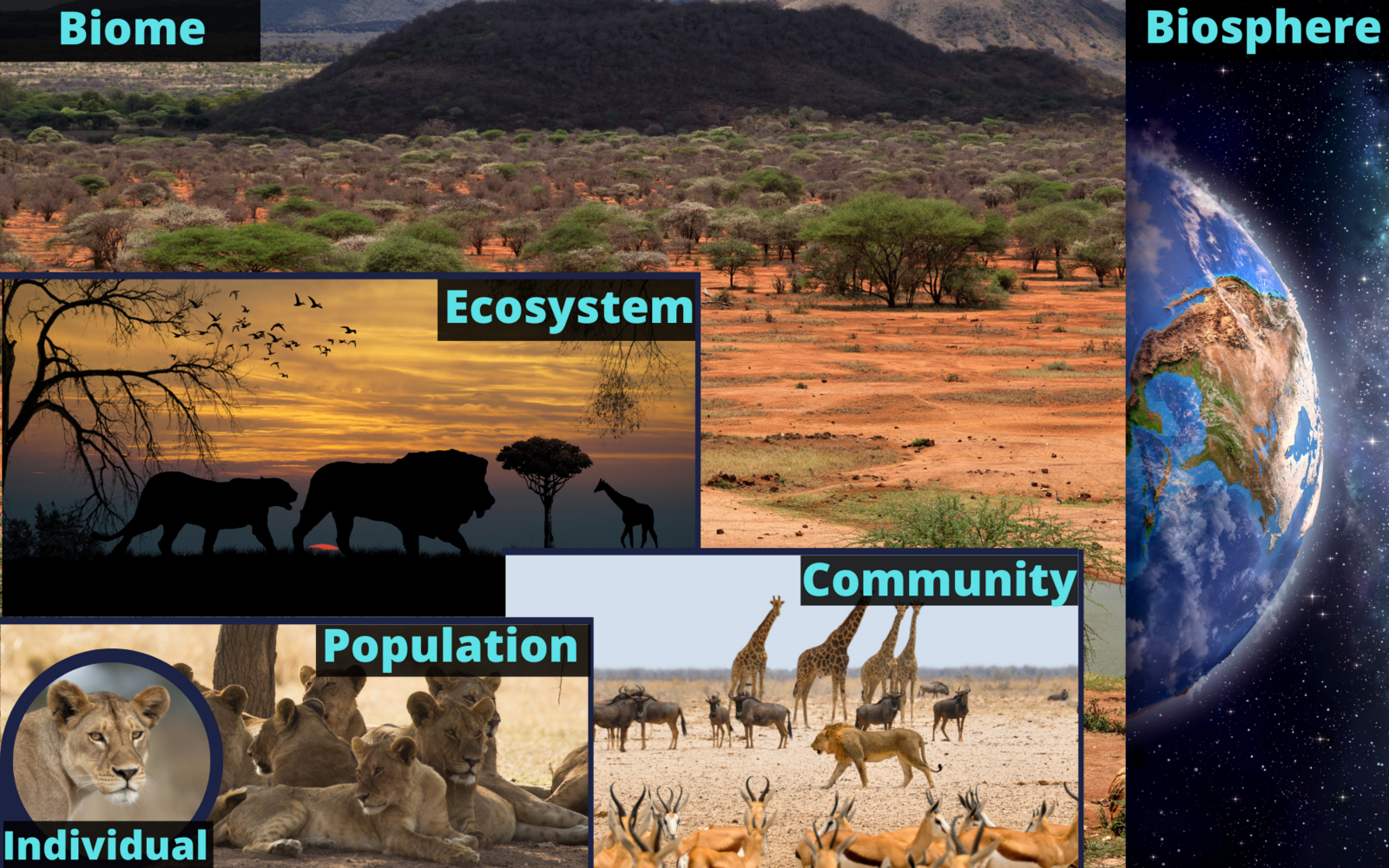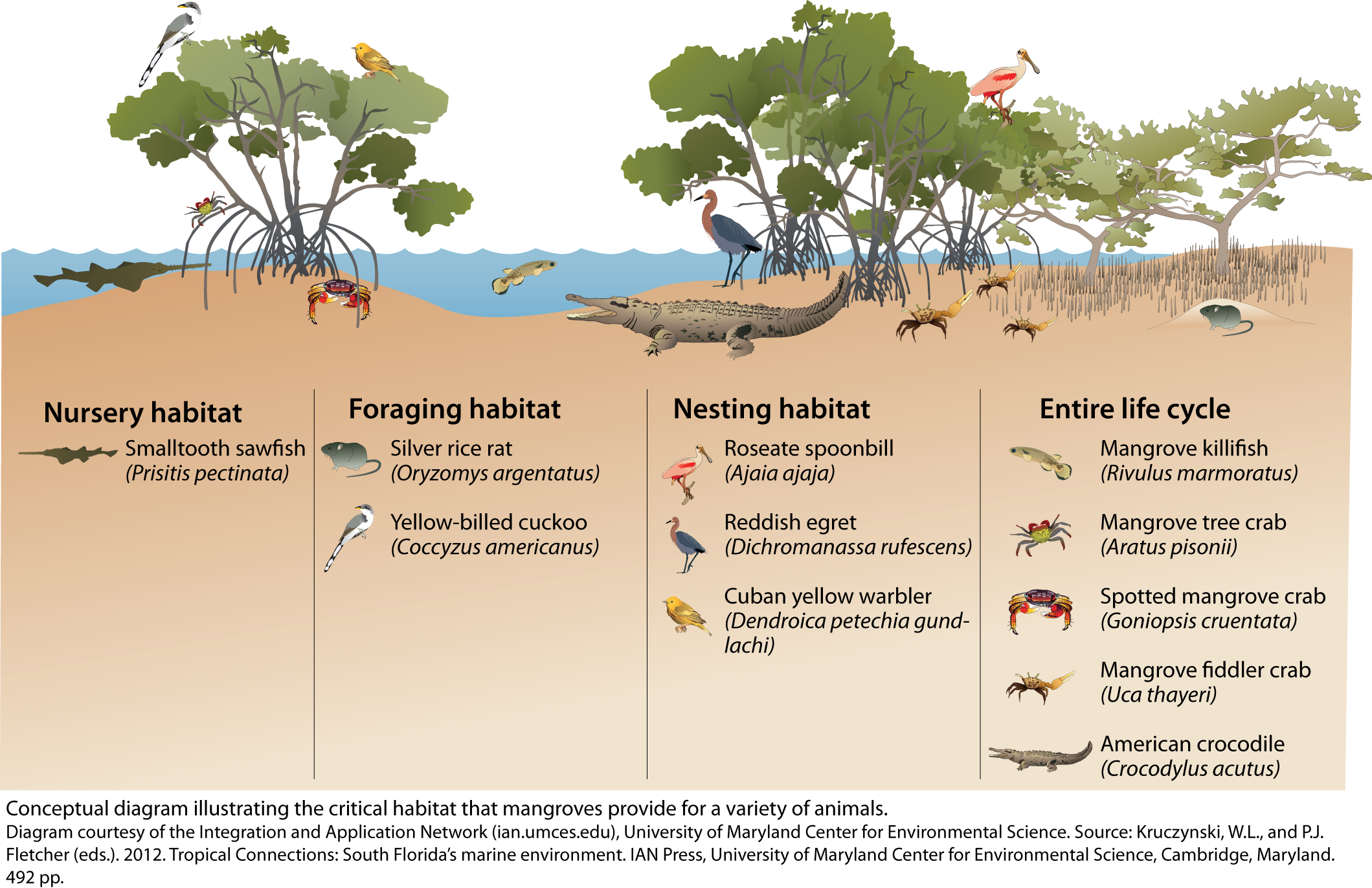IB Syllabus focus:
‘Ecological organization spans organism → population → community → ecosystem → biosphere; a habitat is the place a species lives within its required environmental conditions.’
Understanding how life is organised in ecological systems is essential for Environmental Systems and Societies. Ecological organisation explains how organisms interact and survive within specific habitats.
Levels of Ecological Organisation
Organism
The organism is the fundamental unit of ecology. It represents an individual living entity that carries out essential life processes such as growth, reproduction, and response to stimuli.
Organism: An individual living entity that maintains its own metabolism and interacts with its environment.
Each organism is adapted to survive within a particular range of environmental conditions, often referred to as its ecological tolerance limits.
Population
A population is a group of organisms of the same species living in the same area at the same time, capable of interbreeding. Populations are studied to understand growth patterns, survival, and changes in abundance.
Population: A group of individuals of the same species occupying a specific area at a given time.
Populations are dynamic, changing due to births, deaths, immigration, and emigration.
Community
A community consists of all populations of different species living and interacting in a defined area. Communities show complex relationships such as competition, predation, and mutualism.
Community: An assemblage of populations of different species living and interacting within the same environment.
The stability of a community often depends on biodiversity and the presence of key species that maintain balance.
Ecosystem
An ecosystem combines communities with their physical environment. It includes both biotic factors (living organisms) and abiotic factors (non-living components such as climate, soil, and water).
Ecosystem: A community of organisms interacting with each other and with the abiotic environment.
Ecosystems can be small (a pond) or vast (a rainforest), but all are structured by the flow of energy and cycling of nutrients.
Biosphere
The biosphere is the sum of all ecosystems on Earth, encompassing all life and the environments that support it. It extends from the deepest oceans to the highest points where life exists.
Biosphere: The global sum of all ecosystems, where living organisms interact with the atmosphere, hydrosphere, and lithosphere.
This is the broadest level of ecological organisation, reflecting planetary-scale processes.
Habitats
The Meaning of Habitat
A habitat is the natural environment where a species lives. It provides the conditions necessary for survival, including food, shelter, mates, and favourable climate.
Habitat: The place where a species lives, defined by the environmental conditions it requires to survive and reproduce.
Each species has a specific habitat that suits its ecological requirements. For example, amphibians require moist environments, while cacti are adapted to arid habitats.
Factors Determining Habitats
Habitats are shaped by a range of conditions:
Abiotic factors such as temperature, rainfall, soil type, salinity, and pH.
Biotic factors such as competition, predation, and the presence of food sources.
Geographical features like elevation, latitude, and proximity to water.
A change in one of these conditions can alter the suitability of a habitat for a species.
Habitat Diversity
Habitats vary in complexity and diversity. High-diversity habitats, like tropical rainforests, contain many niches and species, whereas low-diversity habitats, like deserts, support fewer species adapted to harsh conditions.
Habitat vs. Niche
It is important to distinguish between habitat and niche. The habitat is where an organism lives, while the niche is the role the organism plays within the ecosystem.
Linking Ecological Organisation to Habitats
From Organism to Biosphere
The concept of ecological organisation provides a framework for linking individuals to the global biosphere:
An organism occupies a habitat that meets its survival needs.
A population forms when multiple organisms of the same species share the same habitat.
Multiple populations interact to form a community within that habitat.
Together with abiotic factors, the community becomes part of an ecosystem.
All ecosystems combined make up the biosphere, the largest unit of ecological organisation.

Diagram showing ecological organisation from an individual through population, community, and ecosystem to the biosphere. This visual directly supports the syllabus hierarchy; note that biome appears as an additional grouping in some frameworks and is not required by the IB specification here. Source.
Importance for Environmental Systems and Societies
Understanding ecological organisation and habitats is critical for:
Analysing species distributions.
Recognising the effects of environmental change.
Managing ecosystems sustainably.
Predicting how human activities may disrupt habitats and ecological balance.
Habitats supply the conditions and resources (e.g., appropriate temperature range, water availability, shelter, food, and access to mates) needed for survival and reproduction.

Conceptual diagram of a mangrove habitat indicating how physical structure and conditions support species by providing shelter, nesting sites, and foraging opportunities. This exemplifies a habitat as the place meeting a species’ required environmental conditions; the multiple species depicted are extra contextual detail beyond the syllabus minimum. Source.
FAQ
A habitat is the broader environment in which a species lives, while a microhabitat refers to a smaller, specialised area within that habitat.
For example, a forest may be the habitat for many birds, but a particular bird may use a tree hollow as its microhabitat. These differences allow multiple species to coexist by reducing competition.
Scale determines how patterns are observed and analysed. A population of insects may be studied within a single tree, but at a larger scale, an entire forest might represent multiple interacting populations forming a community.
Understanding scale helps ecologists decide on appropriate sampling methods and ensures data is meaningful at the level being investigated.
Environmental gradients such as light intensity, moisture, and temperature influence which species can survive in specific areas.
Species distributions often follow gradients, e.g., plants at different soil moisture levels.
Sharp changes in gradients can create boundaries between habitats, such as the edge of a desert and a grassland.
Yes. A single species can be part of multiple communities if it occupies more than one habitat across its range.
For instance, foxes may be part of woodland, farmland, and urban communities, interacting with different populations in each environment. This adaptability often increases species resilience to environmental change.
Ecosystem boundaries are often defined by observable changes in abiotic conditions or community composition.
A shoreline separates aquatic and terrestrial ecosystems.
Soil type or vegetation shifts may signal a transition.
Boundaries are not always fixed and can be diffuse, depending on the interactions between organisms and their environment.
Practice Questions
Question 1 (2 marks)
Define the terms population and community as used in ecology.
Mark scheme:
Population: Group of individuals of the same species living in the same area at the same time. (1 mark)
Community: An assemblage of populations of different species living and interacting in the same environment. (1 mark)
Question 2 (5 marks)
Using examples, explain how the concepts of habitat and ecosystem differ, and describe how they are linked within the hierarchy of ecological organisation.
Mark scheme:
Habitat: The place where a species lives, defined by the environmental conditions required for survival. (1 mark)
Ecosystem: A community of organisms interacting with each other and with abiotic factors. (1 mark)
Clear explanation of the difference (habitat refers to a single species’ living place; ecosystem refers to interactions between multiple species and their environment). (1 mark)
Example of a habitat (e.g., mangrove tree roots for crabs) and an ecosystem (e.g., a mangrove forest including water, soil, and organisms). (1 mark)
Link to hierarchy: habitats of species form part of populations and communities which together with abiotic factors constitute ecosystems. (1 mark)

